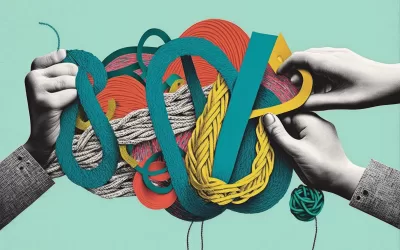Post-pandemic organizations are quickly evolving to tell their narrative. Environmental, Social, and Governance (ESG) themes are being redrafted into company-wide communications. As part of the process, organizations are struggling to overcome biases. Whose voice should be included? What themes should be stressed? How do we remain authentic and transparent to our ethos? Each internal stakeholder from the front-line employee to management brings their own cognitive perspective on what themes should be prioritized, what the messaging wrapper should entail, and how that narrative is expected to impact the customer experience. What is the process to diagnose assumptions to bring an empathetic approach that is human-centered at its core?
Make decisions based on insights, not assumptions.
We’ve read through strategic plans which outline business priorities and themes based on goals and key performance indicators. When we ask how these plans are developed, we find missed opportunities in data collection. Informing the narrative requires unbiased questioning. How do you perceive our company? From a scale of low/medium/high, how do you feel we are tackling (insert theme here)? Where do you believe we’re missing the mark? Sending out a stakeholder questionnaire helps develop themes into a compelling narrative. Include an intro before the survey to share with participants your goals and how their valued insights will help impact the organization.
Compare what has been previously done vs. what will be done in the future.
Organizational design optimizes consistency standards. These operational processes are crucial especially during the employee onboarding and engagement cycles. For a business to act in sync, a harmonious narrative needs to be done irrespective of any inherited biases they may bring into their roles. ESG narratives specifically cannot make an impact if there isn’t accountability and structure in sharing the same communications to the customer. Corporate communications and marketing initiatives rely on the historical trend of themes. What stance has our organization historically taken? Are we continuing these themes or are we pivoting? If we’re evolving, how are we communicating this change to all stakeholders? Do our customers really get who we are?
Innovate by testing desirability, viability, and feasibility.
Innovative practices require a solution-centric mindset. Companies typically look to initiatives that are marketable – those which have an opportunity to enhance new business development. In an effort to steer away from greenwashing, these initiatives should be tested using IDEO’s design thinking framework. Organizations should ask these questions to remove bias when bringing new narratives (and initiatives) to the table:
- Is this desirable? Is this something that our customers need? Consider the customer experience and their pain points.
- Is this feasible? Do we have the capabilities to move the needle on this? Potential considerations include budget, skillset, and internal traction.
- Is this viable? Will this contribute to long-term growth? Look at not only revenue generation but also sustainability impact to the community and society.
Prioritize design as your top tool.
Innovation by design brings a thoughtful approach to the customer experience. Designing business strategy, messaging, and marketing initiatives will require an elevated emphasis on design thinking. Fast Company asked over 30 experts where design can make the biggest impact in the next decade and the answers are eye-opening.
- “In the next decade, I’m genuinely excited to see more diversity of thought brought to fruition, reflecting what makes us unique and embracing a thoughtful approach that brings out the richness of the world.” – Albert Shum, corporate vice president of design, Microsoft
- “For these generations, design’s value will be determined by its ability to eliminate the conditions of vulnerability for the land, the water, the air, and all that lives within them.” – Dori Tunstall, dean of the faculty of design, Ontario College of Art & Design University
- “We need to pivot from the disconnected, crowded ecosystems that offer users everything at once and design for intelligent orchestration that leverages context to deliver on the right experience at the right time without compromise.” – Derek Fridman, design partner, Work & Co.
- “I think the challenge facing all of us in the 21st century (what cultural historian Thomas Berry called the Great Work of the 20th/21st century) is how to intentionally transition our organizations, communities, and entire societies toward more sustainable, equitable, and desirable long-term futures.” – Terry Irwin, director, Carnegie Mellon’s Transition Design Institute
Value creation can be reached by diagnosing biases. To move away from internal assumptions and focus on the customer experience, organizations need a process and design thinking framework to tell their narrative. Informed insights can bring an authentic, human-centered voice to corporate communications. Historical patterns in this narrative do not always inform the continued action plan moving forward. Rather, strategic considerations should be made whether the programmatic initiatives truly capture the story and voice of today’s customer experience. Are our initiatives desirable, feasible, and viable – or are they just filling our marketing team’s time (and budget) to see which tactics resonate with our audience? At organizations, design thinking transcends roles and departments to bring change and impact. Moving forward, the only way to truly break through crowded ecosystems will be to listen, digest, and capture insights that translate to a more engaging customer experience.




